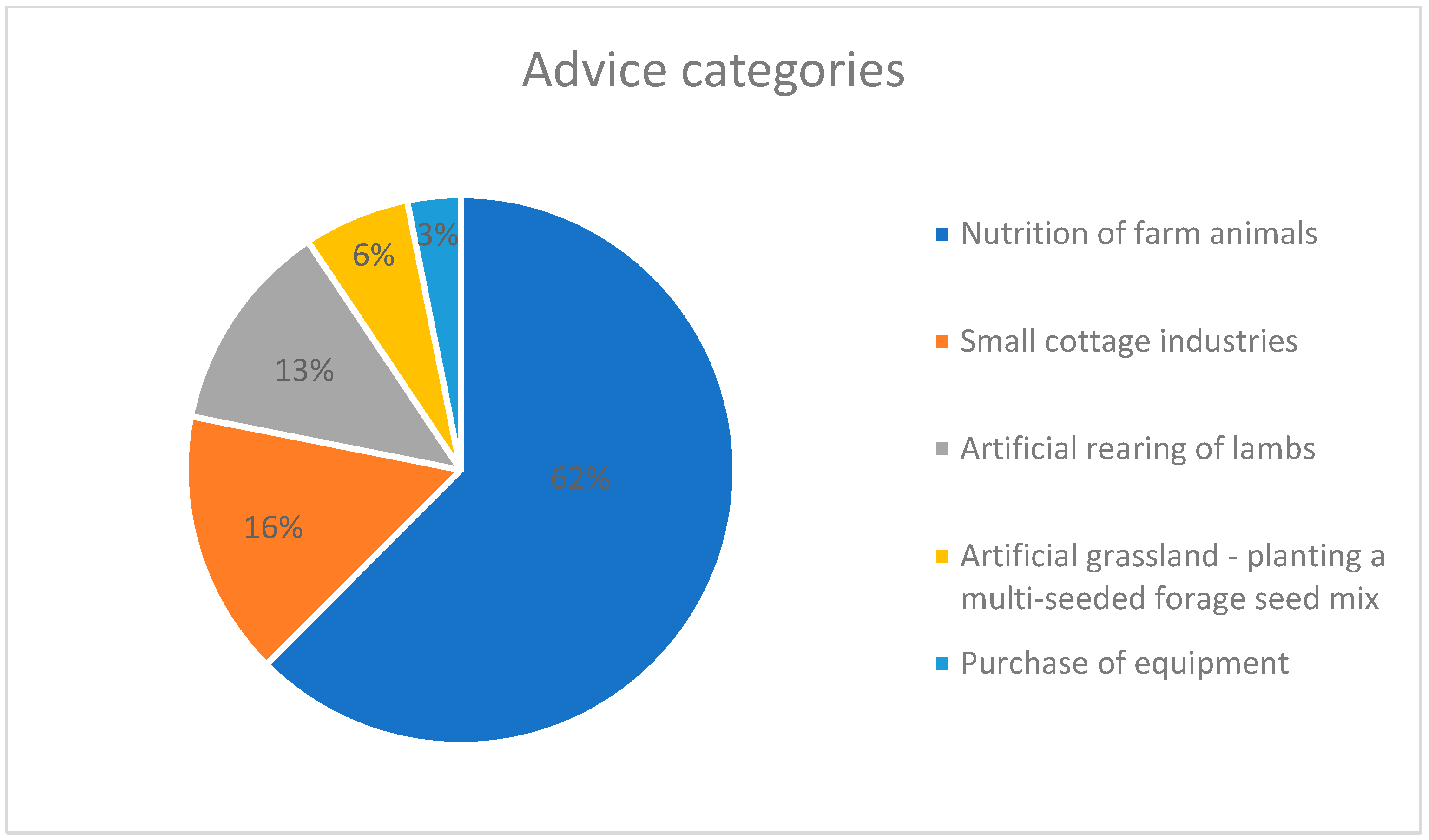Upgrading Value Chains through Farm Advisory †
Abstract
1. Introduction
2. Methods
3. Results and Discussion
4. Conclusions
Author Contributions
Funding
Institutional Review Board Statement
Informed Consent Statement
Data Availability Statement
Conflicts of Interest
References
- Manikas, I.; Sundarakani, B.; Anastasiadis, F.; Ali, B. A Framework for Food Security via Resilient Agri-Food Supply Chains: The Case of UAE. Sustainability 2022, 14, 6375. [Google Scholar] [CrossRef]
- Spilioti, M.; Stachtiaris, S.; Kominakis, A.; Karanikolas, P.; Tsiboukas, K. A niche strategy for geographical indication products, by valorising local resources: The Greek cheese Ladotyri Mytilinis. Int. J. Agric. Resour. Gov. Ecol. 2022, 18, 160. [Google Scholar] [CrossRef]
- Bacon, C.M.; Getz, C.; Kraus, S.; Montenegro, M.; Holland, K. The Social Dimensions of Sustainability and Change in Diversified Farming Systems. Ecol. Soc. 2012, 17, 41. [Google Scholar] [CrossRef]
- Ferris, S.; Robbins, P.; Best, R.; Seville, D.; Buxton, A.; Shriver, J.; Wei, E. ‘Linking Smallholder Farmers to Markets and the Implications for Extension and Advisory Services’ MEAS. 2014. Available online: https://agritech.tnau.ac.in/dmi/2013/pdf/MEAS%20Discussion%20Paper%204%20-%20Linking%20Farmers%20To%20Markets%20-%20May%202014.pdf (accessed on 25 June 2023).
- Spilioti, M.; Karanikolas, P.; Kominakis, A.; Stachtiaris, S.; Tsiboukas, K. Geographical indication products and the provision of public goods—A Greek case study. Int. J. Sustain. Agric. Manag. Inform. 2023, 9, 136–158. [Google Scholar] [CrossRef]
- Kahan, D. ‘The role of the FARM MANAGEMENT SPECIALIST in extension’ FAO. 2013. Available online: https://www.fao.org/3/i3232e/i3232e.pdf (accessed on 25 June 2023).
- Dockès, A.-C.; Chauvat, S.; Correa, P.; Turlot, A.; Nettle, R. Advice and advisory roles about work on farms. A review. Agron. Sustain. Dev. 2019, 39, 2. [Google Scholar] [CrossRef]
- European Commission. Agricultural Knowledge and Innovation Systems (AKIS), Boosting Innovation and Knowledge Flows across Europe. 2022. Available online: https://ec.europa.eu/eip/agriculture/sites/default/files/eipagri_agricultural_knowledge_and_innovation_systems_akis_2021_en_web.pdf (accessed on 12 May 2023).
- New Agriculture New Generation. Workforce Development. 2023. Available online: https://www.generationag.org/symboyleytikh-yposthriksh-aigoprobatotrofon-karditsas (accessed on 12 May 2023).
- Makkar, H. Review: Feed demand landscape and implications of food-not feed strategy for food security and climate change. Animal 2018, 12, 1744–1754. [Google Scholar] [CrossRef] [PubMed]
- Stefanakis, A.; Volanis, M.; Zoiopoulos, P.; Hadjigeorgiou, I. Assessing the potential benefits of technical intervention in evolving the semi-intensive dairy-sheep farms in Crete. Small Rumin. Res. 2007, 72, 66–72. [Google Scholar] [CrossRef]
- Gelasakis, I.A.; Valergakis, E.G.; Fortomaris, P.; Arsenos, G. Farm conditions and production methods in Chios sheep flocks. J. Hell. Vet. Med. Soc. 2018, 61, 111–119. [Google Scholar] [CrossRef][Green Version]
- Garrity, P.D. Agroforestry and the achievement of the Millennium Development Goals. Agrofor. Syst. 2004, 61, 5–17. [Google Scholar]
- Eastwood, R.C.; Chapman, D.; Paine, M. Networks of practice for co-construction of agricultural decision support systems: Case studies of precision dairy farms in Australia. Agric. Syst. 2012, 108, 10–18. [Google Scholar] [CrossRef]


| Brief Description of Advice | Capacity of Animals | Total Impact of Advice | Impact of Advice per Ewe (Euros) |
|---|---|---|---|
| Improvement of Existing Ration (IER) | Ewes: 220 | Increase of the Gross Added Value (IGAV): 18,121 euros | IGAV: 82.4 euros per ewe |
| IER, after previously grouping the dairy ewes according to body weight | Ewes: 240 | IGAV: 10,055 euros | IGAV: 41.9 euros per ewe |
| ARL | Ewes: 500 Lamb: 750 | IGAV: 10,235 euros | IGAV: 20.5 euros per ewe |
| Expansion of distribution channels and addition of new products to the existing ones in cottage cheese production | Ewes: 100 Goats: 30 | Increase in Revenue (IR) by 9698 euros | IR: 97 euros per eve |
| IER | Ewes: 100 Goats: 30 | IGAV: 5300 euros | IGAV: 53 euros per ewe |
Disclaimer/Publisher’s Note: The statements, opinions and data contained in all publications are solely those of the individual author(s) and contributor(s) and not of MDPI and/or the editor(s). MDPI and/or the editor(s) disclaim responsibility for any injury to people or property resulting from any ideas, methods, instructions or products referred to in the content. |
© 2024 by the authors. Licensee MDPI, Basel, Switzerland. This article is an open access article distributed under the terms and conditions of the Creative Commons Attribution (CC BY) license (https://creativecommons.org/licenses/by/4.0/).
Share and Cite
Spilioti, M.; Karanikolas, P.; Papadomichelakis, G.; Tsiboukas, K.; Voloudakis, D. Upgrading Value Chains through Farm Advisory. Proceedings 2024, 94, 39. https://doi.org/10.3390/proceedings2024094039
Spilioti M, Karanikolas P, Papadomichelakis G, Tsiboukas K, Voloudakis D. Upgrading Value Chains through Farm Advisory. Proceedings. 2024; 94(1):39. https://doi.org/10.3390/proceedings2024094039
Chicago/Turabian StyleSpilioti, Maria, Pavlos Karanikolas, George Papadomichelakis, Konstantinos Tsiboukas, and Dimitris Voloudakis. 2024. "Upgrading Value Chains through Farm Advisory" Proceedings 94, no. 1: 39. https://doi.org/10.3390/proceedings2024094039
APA StyleSpilioti, M., Karanikolas, P., Papadomichelakis, G., Tsiboukas, K., & Voloudakis, D. (2024). Upgrading Value Chains through Farm Advisory. Proceedings, 94(1), 39. https://doi.org/10.3390/proceedings2024094039






